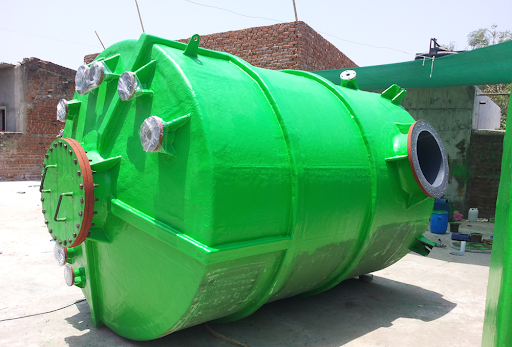FRP Tanks
FRP (Fibreglass Reinforced Plastics, also known as GRP, or Glass Reinforced Plastics) is a modern composite material of construction for chemical plant equipment like tanks and vessels. Chemical equipment that range in size from less than a metre to 20 metres are fabricated using FRP as material of construction.
FRP tank is a storage vessel, devised from the FRP material featuring excellent corrosion, UV, temperature, flame and chemical resistance and hence it ensures longer shelf life under diverse conditions, unlikely to other tanks. Due to its remarkable aspects this FRP tanks are extensively popular in chemicals, water, waste water, oil, petroleum, gas, and all other analogous industries for storage purpose.
Abundant storage tank sizes and customization options
Our FRP tank capacities range from 500 to 50,000 gallons and can be availed in the different specifications as per the requirements. The size, height, single wall, double wall, insulated, underground, aboveground tank options are available at the most likely rates to us. Moreover, customization of the FRP and PP FRP tanks is available, where our engineering and drafting personnel ensure you get the perfectly designed tank for your exclusive needs.
Major Facts of FRP Tanks to approach
1. Cost Effective
2. Non Toxic – Environmental friendly
3. Durable – Longer service life
4. Electrically non conductive
5. Superior strength to weight ratio
6. Corrosion Resistance
7. High heat distortion temperature
FRP tank Application Industries
8. Chemical Industries
9. Agricultural
10. Pharmaceutical
11. Food & Beverages
12. Petrochemicals
13. Aquaculture
14. Pulp & Paper
15. Water & wastewater

Why have we used FRP material in Tanks?
FRP has been a favorite material for the composition of the various products since it was invented, due to sharing some of the unrivalled characteristics, which are hard to find together in other polymers. The properties for which we have adopted FRP covers:
- High strength to weight ratio
- Lightweight with high strength
- Completely recyclable – Environmental friendly
- Excellent resistance against corrosion
- Outstanding impace resistance
- Retention of dimensional stability across a broad range of temperatures
- Considerable Level of stiffness
- Good electrical insulating properties
- Non-magnetic and non-sparking
- Low thermal conductivity
- Versatile Design freedom
- Rapid installation with standard tools
- RF transparency
FRP TANKS vs CONCRETE TANKS
Considering all the advantages of the FRP and concrete associated with the installation, maintenance and durability,
FRP tanks are much more cost effective than that of concrete tanks.
FRP tanks do not contain any metal parts and therefore they do not experience any degradation all through the life span. Further, there is no galvanic action responsible for the degraded performance.
FRP is known for its excellent corrosion resistance aspect and therefore tanks made of the FRP material never rust. Additionally, the use of the hot press molding technology delivers absolutely smooth surface prevents microbial induced corrosion, whereas concerted tanks are porous and therefore increased chance for the corrosion.
Unlike concrete, FRP is a nonporous material and hence no dilation is experienced in the FRP tanks. Furthermore, the stability of the FRP material provides an absolute seal and prevents cracks and leaks due to expansion or contraction over time.
FRP tanks do not require special monitoring, seal replacement, overlay across the life and therefore FRP tanks require no maintenance all through its lifetime, unlike the concrete.
Surprisingly, FRP tanks are 30 times lighter than a concrete tank, which ultimately eliminates the requirement of the heavy cranes for the installation and thus reduces the cost of the installation drastically.
Other than lightweight, the high impact strength aspect of the FRP tanks enables it to withstand any harsh installation conditions without any damage, whilst concrete tanks need to be handled carefully.
FRP tanks are easy to join with other tanks by means of principle of communicating vessels, and permits the user to design the system as per the requirement.
FIBERGLASS vs STEEL
FRP tanks are excellent against corrosion, unlikely to that of stainless steel tanks, which need to be coated internally
and externally in order to prevent corrosion. This coating not only adds to the cost, but also demands maintenance
frequently, whereas excellent corrosion resistance of the FRP tanks does not need any maintenance all through the
lifespan.
FRP tanks have high strength to weight ratio, unlikely to the stainless steel tanks, which hold greater impact strength,
but have four times greater weight of the FRP tanks that leads to higher installation cost.
